
Key Takeaways
- Integrating the Uber API into your app offers improved user experience, process automation, reduced costs, advanced analytics, better efficiency, competitive advantage, and easy integration.
- Businesses in the food & beverage, retail, hospitality, healthcare, transportation & logistics, and business solutions industries mostly benefit from Uber API integration.
- Notable examples of Uber integration include Amazon, Hilton Hotels & Resorts, TripAdvisor, Starbucks, OpenTable, and Jobcase.
Uber is the world’s leading ridesharing and delivery app, occupying 76% of observed U.S. rideshare spending and 25% of the global market share.
And the best part? Uber API integration is publicly available to developers. This means if you’re developing a cloud-based mobile app that needs to incorporate logistics, freight, or shipping services, then with the right developers at your side, you can use the Uber API to make your app stand out in a highly competitive industry.
In this article, we’ll look at the benefits of Uber API and walk you through the integration process. We’ll also describe some examples of companies that have already integrated Uber API.
What Is the Uber API?
The Uber API is a set of rules and mechanisms that allow developers to integrate Uber’s ride-hailing, delivery, and logistics services into their applications. It provides tools for features like ride requests, fare estimates, trip tracking, and delivery management, enabling seamless interaction with Uber’s ecosystem.
Best Examples of Uber API Integration

Thousands of companies have connected Uber to their services and mobile apps as a way of extending and strengthening the features they offer. Here are some example cases of Uber API integration:
Amazon Echo
- Integration use case: Amazon’s goal to create a seamless user experience became even closer to reality with Uber API. Integrating Uber’s functions into the Alexa digital assistant allows users to order food, request trips, or cancel rides without touching their phones.
- Benefits: This integration improves accessibility and efficiency, offering users a faster, more convenient way to manage rides and orders without using their phones. It also demonstrates the potential of voice-driven technology to simplify daily tasks, enhancing user satisfaction and brand loyalty.
Hilton Hotels & Resorts
- Integration use case: Hilton and Uber have expanded their partnership by integrating their mobile apps to enhance the travel experience. Users can now order an Uber directly from the Honors app, while Uber riders can view hotel stay details, check in, choose their room, and request a Digital Key — all while en route to the hotel.
- Benefits: The integration reduces travel friction by streamlining ride booking, hotel check-in, and room selection through features like Ride Reminders and Local Scene. Hilton and Uber deliver a personalized, efficient experience that boosts guest loyalty and makes travel more intuitive.
TripAdvisor
- Integration use case: The collaboration between Uber and TripAdvisor empowers travelers to create personalized, self-guided tours. By combining TripAdvisor’s “Near Me Now” and “Saves” features with Uber’s ride-hailing service, users visit restaurants, museums, and other landmarks based on geo, ratings, and personal preferences.
- Benefits: This solution offers a cost-effective alternative to traditional tours while giving travelers full control over their experiences. With the convenience of TripAdvisor’s recommendations and Uber’s transportation, users visit highly-rated landmarks and hidden gems at their own pace.
Starbucks
- Integration use case: With Uber Eats API integration, Starbucks Delivers represents the company’s commitment to meet evolving customer expectations. This collaboration implements Starbucks’ ordering technology with Uber Eats Developer API, offering a seamless way for customers to enjoy their favorite beverages and food items from anywhere.
- Benefits: UberEats API not only saves time but also caters to modern lifestyles, offering flexible options for busy mornings, office breaks, or relaxing at home. With reliable delivery, real-time order tracking, and full menu customization, Starbucks ensures the same high-quality experience customers expect in-store.
OpenTable
- Integration use case: Uber and OpenTable have collaborated to support the reopening of indoor dining across England. OpenTable curated a list of highly rated restaurants with availability, helping diners discover their ideal dining experience. Complementing this, Uber offered a 50% discount on rides to these restaurants.
- Benefits: The partnership supports the hospitality sector’s recovery from lockdown and simplifies planning a dining outing. It combines transportation and dining reservations into a cohesive experience. Diners benefit from cost savings, convenient booking, and safe travel, while restaurants gain increased footfall and visibility.
Jobcase
- Integration use case: Uber and Jobcase have integrated their platforms, allowing Uber drivers to showcase their ratings on Jobcase profiles, enhancing visibility to potential employers. The partnership also simplifies the Uber driver signup process through the Jobcase Common App via Uber’s API.
- Benefits: Thanks to such a collaboration, drivers stand out to employers, boosting job prospects, while Jobcase members gain streamlined access to Uber driver opportunities to earn extra income.
Reasons for Uber API Integration into Your App

Integration with Uber API can enhance your business in many ways. Here’s a closer look at seven benefits of Uber API integration for your app.
Improved User Experience
Uber is a top-rated driving service. In Q4 2023, Uber’s mobility and delivery services completed more than 2.6 billion trips globally. With Uber’s functionality incorporated in your product, users will be able to schedule quick trips to your company without switching apps.
Process Automation
Uber for Business offers a suite of tools to streamline your workflows and automate tasks. With a team of experienced developers, you can use the API to connect them to your product. With Uber integration, your booking app can offer users a taxi ride option after booking a room or automatically send cars to pick up employees.
Reduced Costs
First, Uber API pricing is free. Also, it saves you the trouble of negotiating with drivers, preparing sign-off agreements, getting loans for cars, and building your logistics. Uber already comes with a massive infrastructure that includes millions of vehicles and drivers. It will cost you less than using an ordinary transportation company and help you focus on generating revenue for your business.
Advanced Analytics
Integrating Uber API into your CRM or SaaS platform will allow you to:
- Implement transportation and operational expenses into financial reports
- Identify and track excessive spending
- Scale logistics for on-demand services
- Analyze routes and detect bottlenecks
- Collect feedback about drivers and couriers to compare their effectiveness
- Learn about the most profitable areas and timetables for your services
Better Efficiency
You can solve transportation issues with Uber Map API. The app relies on the Google Maps API, which offers excellent coverage and location data accuracy, even in rural areas. This allows you to use optimal destination routes, give route-specific estimates for employees and customers, and get precise pick-up and drop-off locations.
Analytics tools can help you determine the most profitable zones for trips and deliveries at particular times of the day.
Competitive Advantage
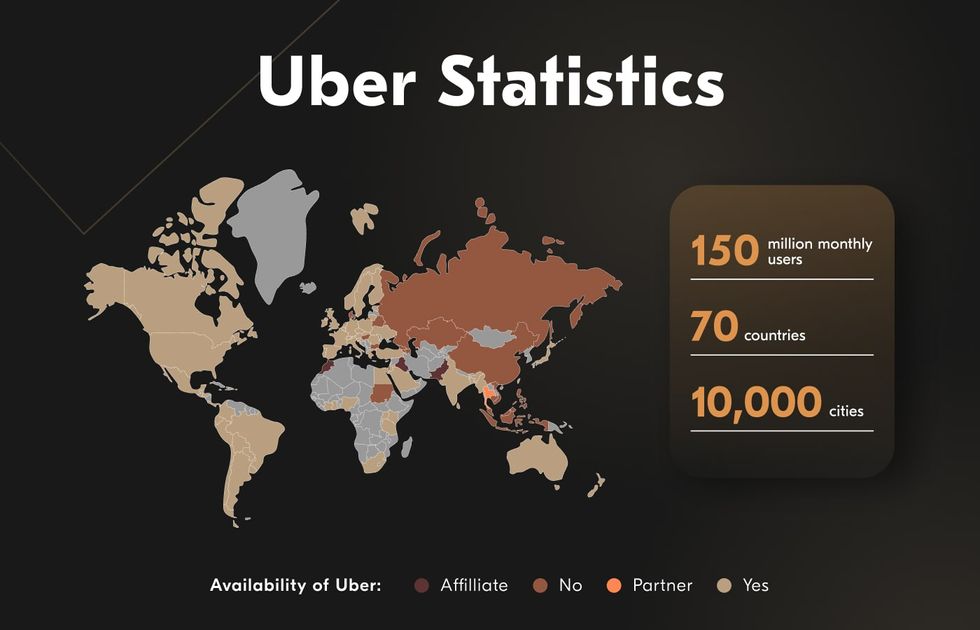
Uber has around 150 million monthly users in 70 countries and over 10,000 cities. As a result, integration with Uber API is one of the easiest ways to reach more clients and improve customer satisfaction rates. Uber’s delivery services enable retailers to offer on-demand solutions without building infrastructure, reducing time to market and solving logistic challenges.
Easy Integration
Uber has built the foundation for advanced delivery and business analytics tools. The app’s back end consists of microservice architecture that allows developers to work on different components of its infrastructure simultaneously. In addition, Uber offers extensive API documentation to make things easier for your development team.
How to Implement Uber API in Your App
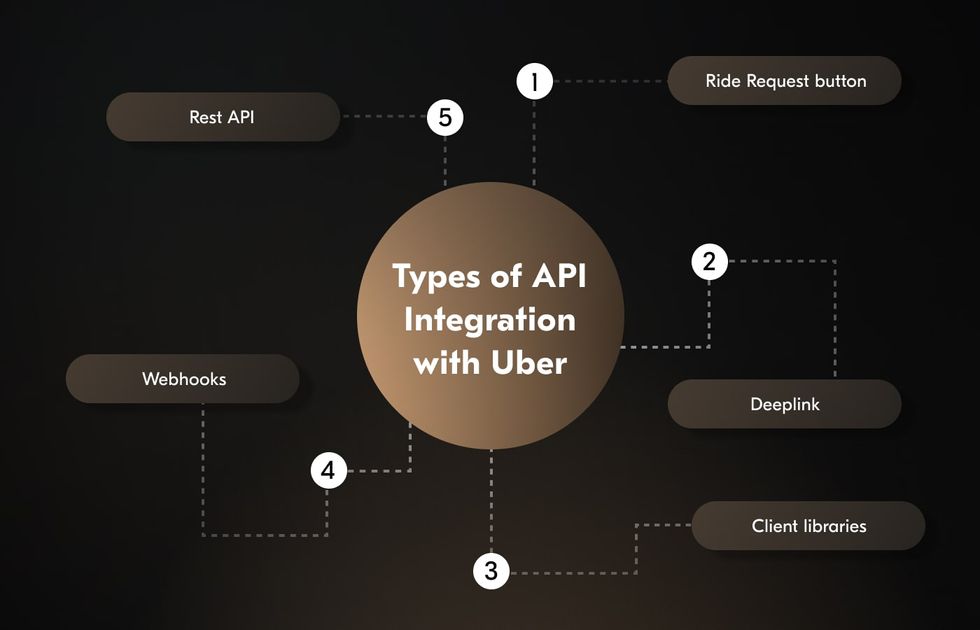
The main benefit of integrating Uber is that you don’t need to create a taxi-hailing or product delivery feature from scratch. But how to use Uber API?
Uber offers the following levels of integration with proper Uber API documentation:
- Ride Request button. With a few lines of code, you can add a button to display - pick-up information and ride estimates. Clicking on it will open the Uber app, allowing the user to order a cab to a predefined location. The Ride Request button is the most straightforward and non-customizable option.
- Deeplink. This is another easy option for Uber API integration on Android and iOS devices. It allows users to launch Uber with predefined pick-up and destination info from your app. In contrast to the Ride Request button, Deeplink integration supports custom logic and visuals.
- Client libraries. Uber supports a whole host of official and unofficial client libraries for your app. The SDKs are available for a wide range of languages to help you create a fully customizable experience.
- Webhooks. Reactive webhooks allow Uber and your app to exchange real-time data to predict user actions, automate processes, or sync data. For example, a restaurant app will automatically offer an Uber cab after you book a table. Likewise, the app can call off a ride if you cancel your reservation. Webhooks are highly versatile, but implementing them requires high-level skills and many resources.
- Rest API. Uber has a RESTful API, meaning it supports all programming languages and coding environments. Building a REST API into your app is nearly impossible without a strong development team but presents the most possibilities for businesses.
Here are some integration examples with Uber API docs to choose from:
- Uber Eats Marketplace APIs for managing stores, menus, and orders
- Uber Direct APIs for creating, managing, and monitoring deliveries
- Vouchers API (Uber Events API) for creating and managing voucher programs and codes
- Uber Driver API for getting profile details, trip data, payments, and ratings
- Uber for Business API for automating business processes and in-depth analytics
Step-by-Step Process of Integrating Uber APIs
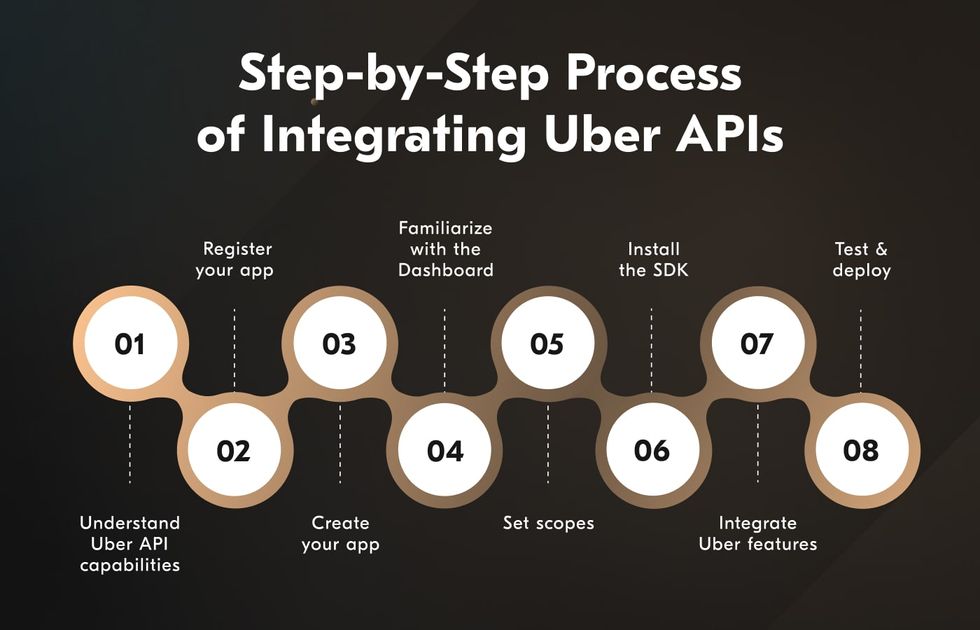
Here are the main steps you need to follow to implement the Uber API example in your app with your in-house developers:
- Understand Uber API capabilities. The Uber API enables ride selection, pickup/dropoff location settings, and price/time estimates, along with ride requests. Explore these features to align with your business needs.
- Register your app. Visit the Uber Developer API Dashboard and create an account. Register your app to get the necessary credentials like Client ID and Client Secret for authentication.
- Create your app. On the Uber Developer Dashboard, click “Create App” to fill in your app’s details. This will allow Uber to generate the required tokens for API access.
- Familiarize yourself with the Dashboard. The Auth tab provides key information such as your Client ID, Client Secret, and Server Token. It’s also where you will configure authentication URLs and app signatures.
- Set scopes. Be selective in choosing scopes to ensure user trust and privacy. General scopes give access to basic user information, while Privileged scopes allow more advanced actions like requesting rides.
- Install the SDK. Uber provides a Software Development Kit (SDK) to help you integrate its services into your app. Developers need to install and configure this SDK based on your preferred implementation: Curl, Python, Java, iOS, or Android.
- Integrate Uber features. Use the SDK to integrate features like ride requests, location services, and price/time estimates into your app. Configure the necessary endpoints and user interface elements for a smooth ride-booking experience.
- Test and deploy. Once integrated, test the Uber functionality within your app to ensure it works correctly. Then, deploy the app to your users.
Which Businesses Can Benefit from Uber API Integration?
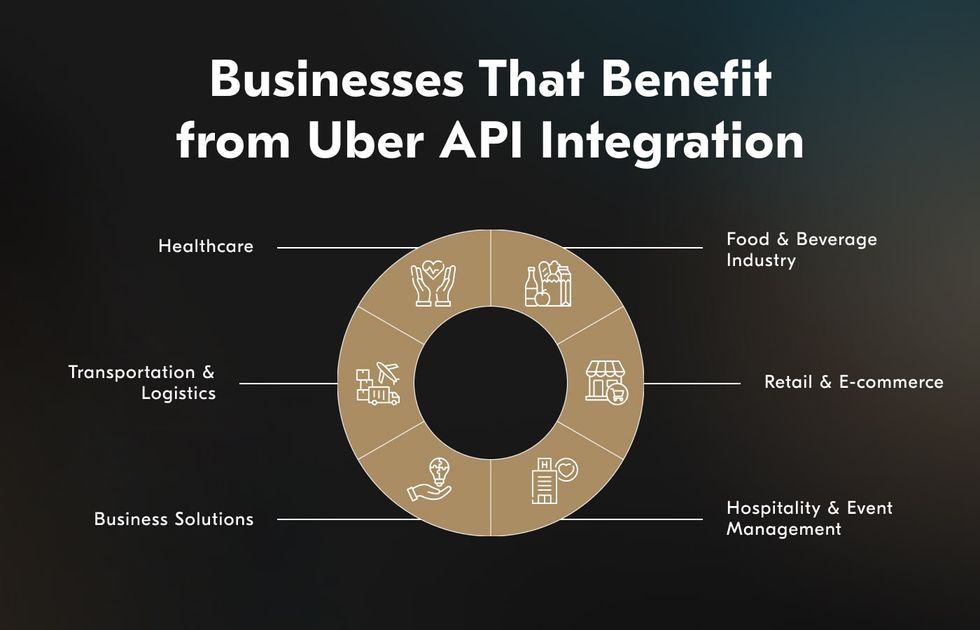
The general benefits of Uber API are clear, but how can you use it to improve your particular business? Here are some ideas and examples for Uber API integration by sector:
Food & Beverage Industry
- Restaurants, cafes, and food delivery businesses use UberEats Developer API to manage stores, menus, and orders, streamlining their operations and reaching a broader customer base.
Retail & E-commerce
- Retailers and e-commerce platforms leverage Uber Direct APIs for last-mile delivery solutions, improving delivery speed and customer satisfaction while managing deliveries in real time.
Hospitality & Event Management
- With Guest Rides API, hotels, resorts, and event organizers provide seamless transportation options for guests. This trendy API helps manage client rides, ensuring they have a hassle-free journey to and from the venue.
- Hospitality businesses also integrate Vouchers API to offer discounts or promotional rides, incentivizing repeat customers and enhancing loyalty.
Healthcare
- By implementing the Uber Health API into your corporate app, you enhance your competitiveness with the latest healthcare trends. For example, you improve patient care and reduce missed appointments by providing a streamlined transportation solution.
Transportation & Logistics
- Drivers API is designed to help companies manage driver profiles, track trips, process payments, and evaluate driver ratings. The focus here is on driver performance and service quality optimization.
- Businesses in the logistics or transportation industry use Supplier Platform API to onboard suppliers, manage vehicles, and assess driver eligibility and risks.
- Integrating the Uber Freight API is a great way to streamline your company and follow logistics trends. You can integrate Uber for real-time tracking, signature confirmation, fast upfront pricing, and load management features.
Business Solutions
- Enterprises use Uber Business API to automate business processes, track employee transportation, and gain insights from in-depth analytics, improving efficiency and cost management.
Why choose Acropolium?
At Acropolium, we’ve been specializing in web and mobile app development services for transportation, logistics, and supply chain businesses since 2003.
Acropolium delivers complex SaaS software solutions that can make a difference. We have decades of expertise in creating proprietary HoReCa software, logistics software, and marketing solutions for startups and larger enterprises. Also, we modernize legacy systems, making them more flexible, scalable, and feature-rich.
Here’s a list of just some of our cloud projects that have benefitted from API integration.
Software for Kiosks and Pharmacies
We created a custom software platform for kiosk devices to help pharmacies connect to their users. Integration of video chat features and the ability to order home delivery led to a 60% increase in profitability, a 54% rise in customer loyalty, and a 47% boost in sales.
SaaS Route Planning Tool
A logistics company integrated a SaaS route planning solution with ML algorithms for real-time traffic analysis and automated route optimization. As a result, the client saw a 15% boost in profit margins, a 25% increase in customer retention, and a 25% improvement in logistics efficiency.
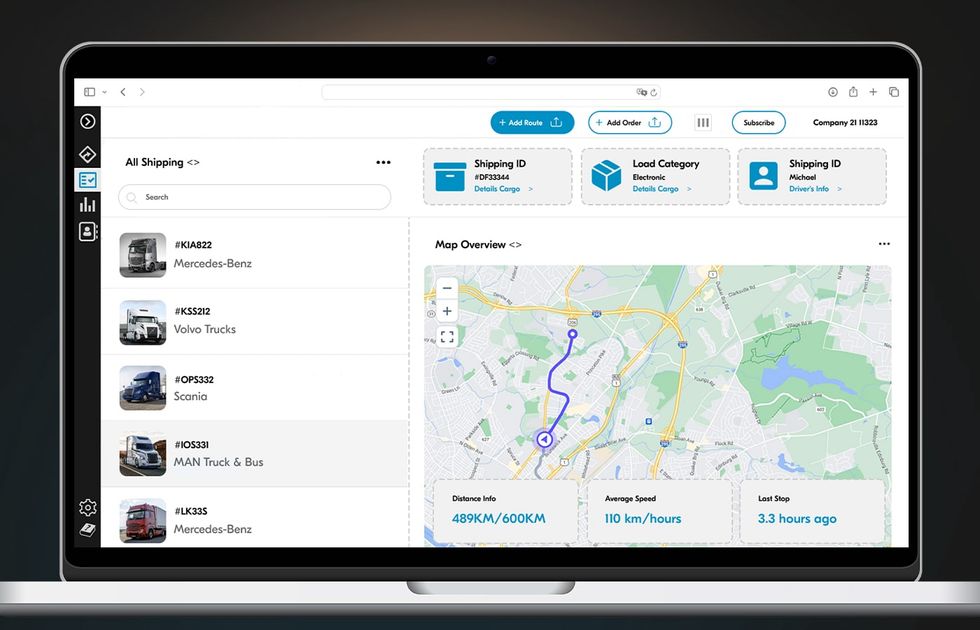
SaaS-Based Live Event Streaming Platform
The client needed a SaaS live streaming platform with payment integration and modernization for better scalability. The platform enabled global event streaming with a 95% reduction in lag and two-second latency while dynamically scaling during peak hours.
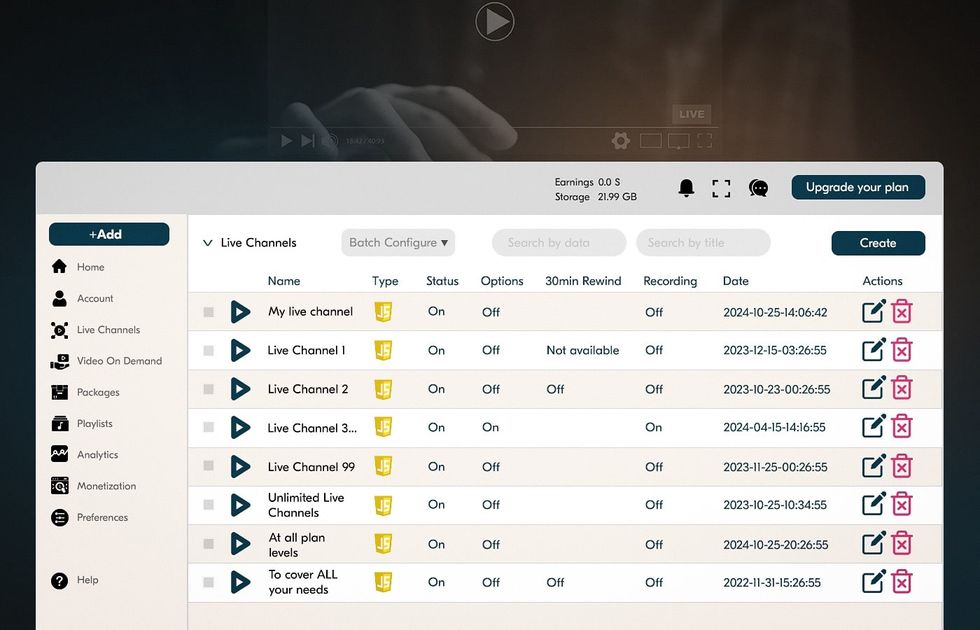
Final Thoughts
As shown by the examples in this article, there are undeniable benefits of integrating the Uber API for startups, SMBs, and large enterprises. For example, it offers seamless ride-hailing and delivery services, reduces the development budget, enhances user experience, and gains valuable analytics.
However, you’ll need a verified Uber API developer if you want to incorporate high-end capabilities into your software platform. Our IT outsourcing dedicated team knows the ins and outs of API integration and would love to get to work on your next project. Contact us to talk about your project and get a proper estimation.









![Transportation Management Software Development [2025 Guide]](/img/articles/transportation-software/img01.jpg)

![IoT in Fleet Management: [Use Cases, Trends & Case Studies]](/img/articles/employing-iot-for-fleet-management-benefits-use-cases-and-success-stories/img01.jpg)
![Multi-Carrier Shipping Software: [8 Use Cases & Key Benefits]](/img/articles/multi-carrier-shipping-software-a-guide-to-enhancing-shipping-efficiency/img01.jpg)
![Transportation Telematics System: [Benefits, Challenges & Use Cases]](/img/articles/the-power-of-telematic-systems-in-transportation-benefits-challenges-and-use-cases/img01.jpg)
![Blockchain for Supply Chain Management: [Benefits & Use Cases]](/img/articles/why-and-how-to-employ-blockchain-in-supply-chain-management-tips-and-success-stories/img01.jpg)